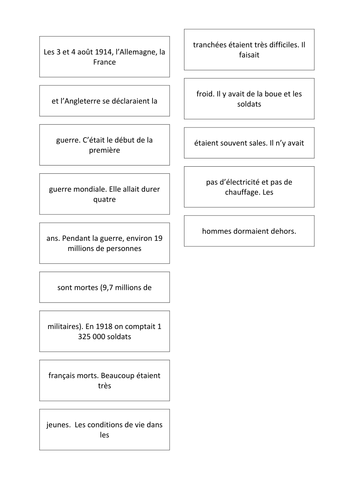





I designed these activities to commemorate the centenary of the outbreak of the First World War. These resources could also be used each year to commemorate the Armistice.
I really wanted the students to experience and express an emotional connection with the topic and can honestly say that they produced some extremely moving written work in response to the material. They were also studying themed lessons in History, English and Drama lessons on the topic of World War 1.
I spent 2 lessons on these activities and used them with my Year 9 students (aged 13-14). I feel it would also work well with Year 10 students (aged 14-15) and younger Gifted students. The PowerPoint guides you through the material.
It starts with a YouTube link to play as the students enter the classroom. This shows footage of trench warfare and I felt this powerfully set the scene for the lesson to come.
Slide 3 presents the objective: To learn about La Première Guerre Mondale and to respond creatively to your learning. This is then differentiated into All, Most and Some.
I then give out the cards to unjumble the following text:
Les 3 et 4 août 1914, l’Allemagne, la France et l’Angleterre se déclaraient la guerre. C’était le début de la première guerre mondiale. Elle allait durer quatre ans. Pendant la guerre, environ 19 millions de personnes sont mortes (9,7 millions de militaires). En 1918 on comptait 1 325 000 soldats français morts. Beaucoup étaient très jeunes.
Les conditions de vie dans les tranchées étaient très difficiles. Il faisait froid. Il y avait de la boue et les soldats étaient souvent sales. Il n’y avait pas d’électricité et pas de chauffage. Les hommes dormaient dehors.
They found the text unjumbling activity pretty challenging so I circulated and game plenty of support. It is definitely worthwhile printing out slide 4 which gives useful vocabulary translations to support the students.
The students then watch a 4 minute extract from the film Joyeux Noel (make sure you have the English subtitles) and complete the worksheet. If you do not have the DVD you may be able to find the correct extract on YouTube.
The students then have time to produce their creative response. Weaker student can produce and acrostic or a calligramme using their support sheet.
Stronger students may adapt the Nelson Mandela Poem to write about La Guerre.
More gifted students can read through the letter from the frontline in the book Lulu Et La Grande Guerre (scan attached) and write their own letter.
I asked the students to read out/ present their work to the class and we created a stunning display of the student’s work.
Finally there is a slide to reflect on What Went Well (WWW) and Even Better If (EBI).
I really wanted the students to experience and express an emotional connection with the topic and can honestly say that they produced some extremely moving written work in response to the material. They were also studying themed lessons in History, English and Drama lessons on the topic of World War 1.
I spent 2 lessons on these activities and used them with my Year 9 students (aged 13-14). I feel it would also work well with Year 10 students (aged 14-15) and younger Gifted students. The PowerPoint guides you through the material.
It starts with a YouTube link to play as the students enter the classroom. This shows footage of trench warfare and I felt this powerfully set the scene for the lesson to come.
Slide 3 presents the objective: To learn about La Première Guerre Mondale and to respond creatively to your learning. This is then differentiated into All, Most and Some.
I then give out the cards to unjumble the following text:
Les 3 et 4 août 1914, l’Allemagne, la France et l’Angleterre se déclaraient la guerre. C’était le début de la première guerre mondiale. Elle allait durer quatre ans. Pendant la guerre, environ 19 millions de personnes sont mortes (9,7 millions de militaires). En 1918 on comptait 1 325 000 soldats français morts. Beaucoup étaient très jeunes.
Les conditions de vie dans les tranchées étaient très difficiles. Il faisait froid. Il y avait de la boue et les soldats étaient souvent sales. Il n’y avait pas d’électricité et pas de chauffage. Les hommes dormaient dehors.
They found the text unjumbling activity pretty challenging so I circulated and game plenty of support. It is definitely worthwhile printing out slide 4 which gives useful vocabulary translations to support the students.
The students then watch a 4 minute extract from the film Joyeux Noel (make sure you have the English subtitles) and complete the worksheet. If you do not have the DVD you may be able to find the correct extract on YouTube.
The students then have time to produce their creative response. Weaker student can produce and acrostic or a calligramme using their support sheet.
Stronger students may adapt the Nelson Mandela Poem to write about La Guerre.
More gifted students can read through the letter from the frontline in the book Lulu Et La Grande Guerre (scan attached) and write their own letter.
I asked the students to read out/ present their work to the class and we created a stunning display of the student’s work.
Finally there is a slide to reflect on What Went Well (WWW) and Even Better If (EBI).
Something went wrong, please try again later.
This resource hasn't been reviewed yet
To ensure quality for our reviews, only customers who have purchased this resource can review it
Report this resourceto let us know if it violates our terms and conditions.
Our customer service team will review your report and will be in touch.
£3.00
